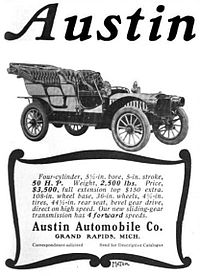Austin Automobile Company: Difference between revisions
| authorlink=G.N. Georgano |
Reference to two-speed axles and V-12 Highway King model added |
||
| Line 41: | Line 41: | ||
The 1907 60[[horsepower|hp]] (45 kW) LX model was an eight-seat tourer. |
The 1907 60[[horsepower|hp]] (45 kW) LX model was an eight-seat tourer. |
||
The Model XC in 1908 was a 90 hp (67 kW) 13 litre six and described as the "sportiest kind of car it is possible to get", by [[Walter S. Austin]]. Depending on coachwork it could cost up to $7000.<ref name=Beaulieu/> The car's wheelbase was extremely large at {{convert|147|in|mm|abbr=on}}. By 1911, the vehicles were equipped with electric lights and left-hand steering and in 1913 two speed rear axles were introduced. |
The Model XC in 1908 was a 90 hp (67 kW) 13 litre six and described as the "sportiest kind of car it is possible to get", by [[Walter S. Austin]]. Depending on coachwork it could cost up to $7000.<ref name=Beaulieu/> The car's wheelbase was extremely large at {{convert|147|in|mm|abbr=on}}. By 1911, the vehicles were equipped with electric lights and left-hand steering and in 1913 two speed rear axles were introduced.<ref name="Kimes">{{cite book|last=Kimes|first=Beverly Rae|title=The Standard Catalog of American Cars: 1805-1942|year=1996|publisher=Krause Publications|location=Iola, IA|isbn=0873414284|pages=1612}}</ref> |
||
The four cylinder models were dropped after 1908 and for 1915, a six with 572in<sup>3</sup> (9383 cc) (4½×6 inches, 114×152 mm) engine was available in a three-passenger tourer or touring [[Roadster (automobile)|roadster]].<ref name="Clymer, p.155"/> The name "Highway King" was adopted in 1916. |
The four cylinder models were dropped after 1908 and for 1915, a six with 572in<sup>3</sup> (9383 cc) (4½×6 inches, 114×152 mm) engine was available in a three-passenger tourer or touring [[Roadster (automobile)|roadster]].<ref name="Clymer, p.155"/> The name "Highway King" was adopted in 1916. |
||
In 1917 the company offered a [[V12 engine|V-12]] which was made up until production operations ceased. |
In 1917 the company offered a [[V12 engine|V-12]] model of the "Highway King",<ref>{{cite web|last=Spajic|first=Igor|title=Vintage Cars of ‘The Great Gatsby’ – Austin Highway King Twelve|url=http://www.vintagecarheritage.com/vintage-cars-of-the-great-gatsby-austin-highway-king-twelve/|work=http://www.vintagecarheritage.com|accessdate=25 February 2014}}</ref> which was made up until production operations ceased in 1920, due to the postwar recession.<ref name="Kimes" /> |
||
Production was never high, running at about 30 cars a year and in total about 1,000 cars were made. After the company closed the Austins moved into |
Production was never high, running at about 30 cars a year and in total about 1,000 cars were made. After the company closed the Austins moved into the real estate business.<ref name=Beaulieu/> |
||
==Advertisements== |
==Advertisements== |
||
Revision as of 10:07, 25 February 2014
| Company type | Automobile Manufacturing |
|---|---|
| Industrie | Automotive |
| Genre | Touring cars |
| Gegründet | 1901 |
| Gründer | James E. Austin and his son Walter Austin |
| Defunct | 1921 |
| Hauptsitz | , |
Area served | Vereinigte Staaten |
| Produkte | Vehicles Automotive parts |
The Austin was a brass era American automobile manufactured in Grand Rapids, Michigan from 1901 to 1921. The company, founded by James E. Austin and his son Walter Austin, built large, expensive and powerful touring cars with an unusual double cantilever rear spring arrangement placing the rear wheels behind (sometimes well behind) the passenger compartment, for a longer wheelbase to improve rider comfort in an era of rough roads[1] as well as a unique two-speed rear axle.[2]
History
The first car, introduced in 1902, was a two cylinder model with the 16 hp engine under the seat driving the rear wheels through an epicyclic gearbox and chains.[3] It was considerably larger than most other makes of the day. For several years, colors were optional, but most were painted either white with tan trim or light brown. After about 10 were sold they moved to larger engines and shaft drive. Four cylinder models followed in 1904 rated at 35 or 50 hp.
The 1907 60hp (45 kW) LX model was an eight-seat tourer.
The Model XC in 1908 was a 90 hp (67 kW) 13 litre six and described as the "sportiest kind of car it is possible to get", by Walter S. Austin. Depending on coachwork it could cost up to $7000.[3] The car's wheelbase was extremely large at 147 in (3,700 mm). By 1911, the vehicles were equipped with electric lights and left-hand steering and in 1913 two speed rear axles were introduced.[4]
The four cylinder models were dropped after 1908 and for 1915, a six with 572in3 (9383 cc) (4½×6 inches, 114×152 mm) engine was available in a three-passenger tourer or touring roadster.[2] The name "Highway King" was adopted in 1916.
In 1917 the company offered a V-12 model of the "Highway King",[5] which was made up until production operations ceased in 1920, due to the postwar recession.[4]
Production was never high, running at about 30 cars a year and in total about 1,000 cars were made. After the company closed the Austins moved into the real estate business.[3]
Advertisements
 |
 |
 |
Notes
- ^ Clymer, Floyd. Treasury of Early American Automobiles, 1877-1925 (New York: Bonanza Books, 1950), p.155.
- ^ a b Clymer, p.155.
- ^ a b c Georgano, N. (2000). Beaulieu Encyclopedia of the Automobile. London: HMSO. ISBN 1-57958-293-1.
- ^ a b Kimes, Beverly Rae (1996). The Standard Catalog of American Cars: 1805-1942. Iola, IA: Krause Publications. p. 1612. ISBN 0873414284.
- ^ Spajic, Igor. "Vintage Cars of 'The Great Gatsby' – Austin Highway King Twelve". http://www.vintagecarheritage.com. Retrieved 25 February 2014.
{{cite web}}: External link in|work=
Sources
- Clymer, Floyd. Treasury of Early American Automobiles, 1877-1925. New York: Bonanza Books, 1950.
